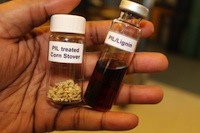
New technique may reduce biofuel production costs
January 8, 2014
By EurekaAlert
 January 8, 2014, Raleigh, N.C. - Researchers at North
Carolina State University have developed a simple, effective and relatively
inexpensive technique for removing lignin from the plant material used to make
biofuels, which may drive down the cost of biofuel production.
January 8, 2014, Raleigh, N.C. - Researchers at North
Carolina State University have developed a simple, effective and relatively
inexpensive technique for removing lignin from the plant material used to make
biofuels, which may drive down the cost of biofuel production.
 January 8, 2014, Raleigh, N.C. – Researchers at North
January 8, 2014, Raleigh, N.C. – Researchers at North
Carolina State University have developed a simple, effective and relatively
inexpensive technique for removing lignin from the plant material used to make
biofuels, which may drive down the cost of biofuel production.
Lignin, nature's way of protecting plant cell walls, is
difficult to break down or remove from plant materials called
"biomass," such as the non-edible parts of the corn plant. However,
that lignin needs to be extracted in order to reach the energy-rich cellulose
that is used to make biofuels.
"Finding inexpensive ways to remove lignin is one of
the largest barriers to producing cost-effective biofuels," says Ezinne
Achinivu, a Ph.D. student in chemical and biomolecular engineering at NC State
and lead author of a study describing the new technique. "And our approach
is very promising."
The researchers began by making a number of liquid salts
called "protic ionic liquids" or PILs. These PILs are fairly inexpensive
to prepare because they are made by mixing together an acid, such as acetic
acid (more commonly known as vinegar), and a base (a chemical class of
materials called amines). As part of the pretreatment process, one of the PILs
is mixed with biomass and then heated and stirred. The lignin dissolves into
the PIL, leaving the cellulose behind as a solid. The cellulose, which is now
much easier to process, is then easily filtered from the mixture for use in the
next biofuel production steps.
The remaining PIL-lignin liquid mixture can then be heated
to distill (or vaporize) the PIL, leaving the lignin behind as a black powder.
The vapors from the PIL are collected and cooled to recover the liquid PIL so
that it can be re-used. The lignin is also valuable, because it can be used to
manufacture polymers or other chemical products, which could supplement the
cost of running the biofuel production facility.
"This PIL-based technique can be easily scaled up and
is likely to be both more energy efficient and less expensive than existing
biomass pretreatment techniques for removing lignin," Achinivu says.
The researchers are currently working to apply the technique
to wood and other biomass feedstock materials, as well as to better understand
and fine-tune the interactions between the PILs and lignin. "If we can
better understand how the PIL dissolves the lignin, we can make the process
even more efficient by using less energy while extracting more lignin,"
Achinivu says.
Print this page